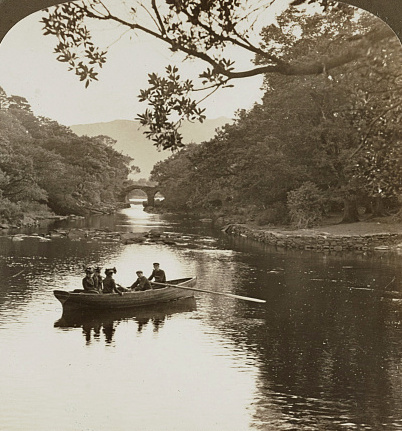The Hunter-Gatherers of Mesolithic Ireland
The first inhabitants of Ireland were hunters and fishermen, who arrived by boat approximately 10,000 years ago.[1] For the next 4,000 years, they survived on the abundant fish, game, and forage of the island's coasts and forests. When new migrants brought agriculture to the island, the landscape of Ireland changed forever. Forests disappeared before stone axes, replaced by fields and bogs. Farming communities sprouted and, while fishing remained a staple, hunting soon lost its importance.[2]
Hunting in Gaelic Ireland
For the most part, only the upper classes of Gaelic Ireland hunted. They kept large dogs, similar to the modern Irish Wolfhound, and hunted on foot. Other methods involved pit-fall traps for deer, boar, and wolves and box traps for hares. Fowl were caught with nets near lakes, bogs, and rivers. On the coasts, men lowered themselves in baskets to collect nesting seabirds and their eggs.[3] Above all, the early Irish prized venison, wild boar, seal, and badger meat for their feasts. Venison in particular was said to be "food fit for a king."[4]
Fishing in Ireland
Fishing, on the other hand, remained vital for the survival of many Irish families. Freshwater fishing was preferred. The rivers of the island draw annual migrations of salmon, trout, and eels to be trapped in nets and weirs. Commercially, dried and salted fish became one of the island's primary exports.[1] In recent centuries, fishing has become a recreational pursuit and a popular tourist attraction. The serene rivers of the island continue to host professional and amateur anglers, while most coastal fishermen now use motorized ships and boats instead of oars and sails.[5]
English Influences and Modern Irish Hunting
When they arrived in Ireland, the Anglo-Normans set aside royal forests for hunting, as they had in Britain. In these lands, wild animals belonged to the king and those he permitted to hunt there. Over the course of several centuries, the new lords of Ireland imported British fallow deer and rabbits to release in the woods. They hunted on horseback with packs of hounds, pelting over fences and fields at dangerous speed. Fashionable Anglo-Irish estates kept their own deer park, stables, and dog kennels. Besides deer and fox, otters, hares, pheasants, and waterfowl were common prey.[6]
Over time, the hunt grew into its own type of ceremony. Formal hunts were accompanied by spectators, servants, and trumpet players, all wearing formal riding outfits and following strict protocol in their pursuit of game. Foxhunting remains legal in the Republic of Ireland and Northern Ireland, though it is a controversial subject and is now illegal in England, Wales, and Scotland. Deer hunting with bows and firearms is an increasingly popular draw for both tourists and residents of the island.[6][7]
Bibliography
Peter C. Woodman, Ireland's First Settlers: Time and the Mesolithic (Oxford: Oxbow, 2015).
G. Frank Mitchell "Introduction" in Treasures of Early Irish Art: 1500 B.C. to 1500 A.D. Metropolitan Museum of Art, ed. (New York: Metropolitan Museum of Art, 1977) 10-15.
Patrick W. Joyce, A Smaller Social History of Ancient Ireland (London, NY, and Bombay: Longmans, Green, & Co., 1906) 494-512.
Patrick W. Joyce, A Social History of Ancient Ireland, Volume 2 (Dublin: Gresham, 1903) 104-148.
Mike Smylie, Ireland: The Fishing Industry Through Time (Gloucestershire: Amberley Publishing, 2014).
Paul Rouse, Sport and Ireland: A History (Croydon: Oxford University, 2015).
Amy Forde, "No Plans to Prohibit Fox Hunting in Ireland - Minister Creed," Agriland, June 10, 2016, Agriland Media, accessed February 26, 2017.
About TOTA
TOTA.world provides cultural information and sharing across the world to help you explore your Family’s Cultural History and create deep connections with the lives and cultures of your ancestors.


